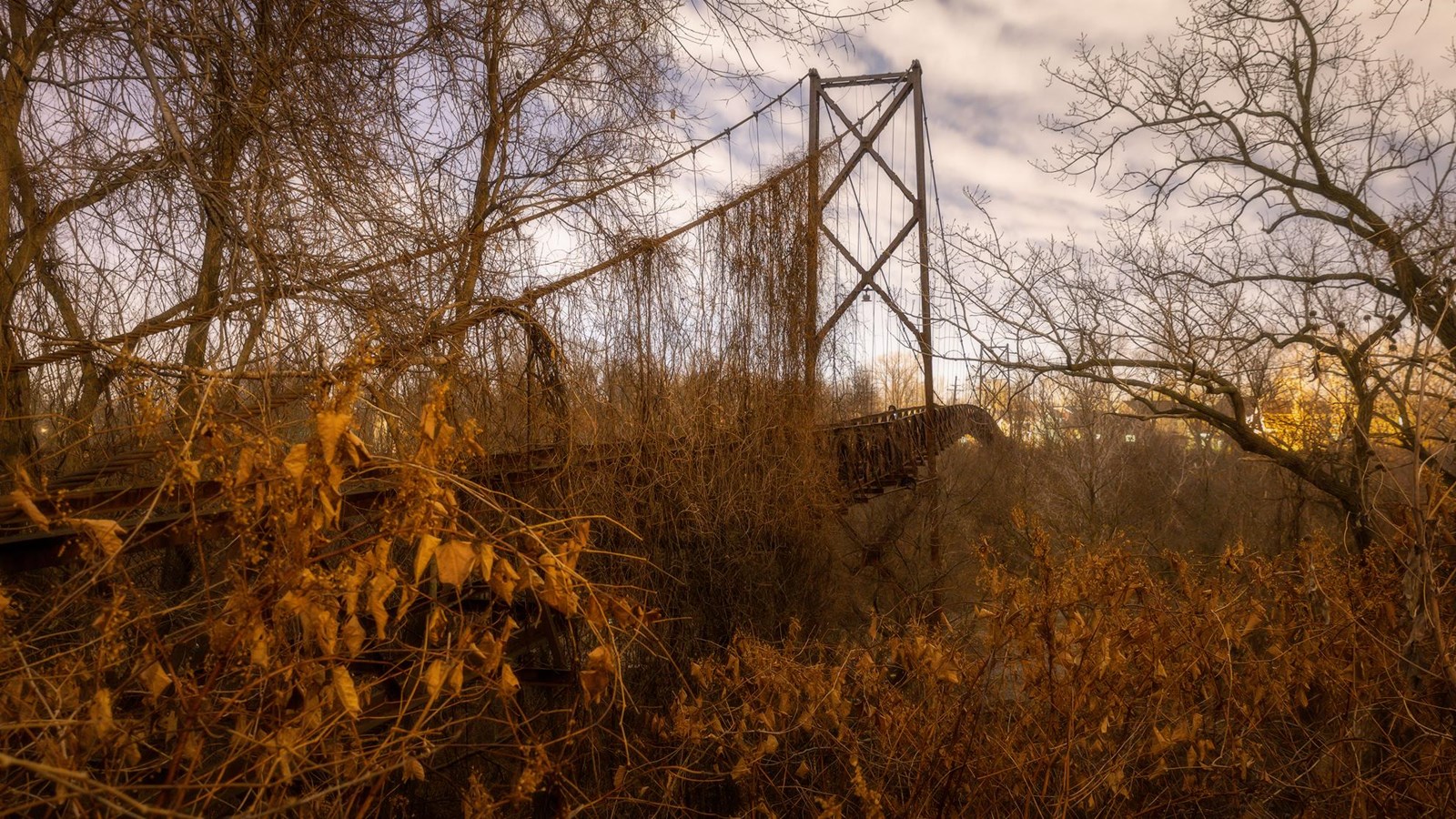Last updated: October 20, 2023
Place
Sidaway Bridge

"Sidaway Bridge" by Matt Shiffler Photography is licensed under CC BY-NC-SA 2.0 DEED via Flickr
Quick Facts
Location:
Sidaway Avenue over Kingsbury Run, connecting Sidaway Ave. and East 67th and Sidaway Ave near Berwick Rd., Cleveland, Ohio
Significance:
Architecture/Engineering, Social History
Designation:
Listed in the National Register - Reference number 100008227
OPEN TO PUBLIC:
No
MANAGED BY:
City of Cleveland
Sidaway Bridge in Cleveland, Ohio was listed in the National Register of Historic Places in 2022. It is significant for its associations with Cleveland civil rights history.
The Sidaway Bridge, a pedestrian suspension bridge and the only such bridge in Ohio documented by the Historic American Engineering Record, was designed by the engineering firm of Wilbur Watson & Associates and by prominent Cleveland civil engineer Fred L. Plummer. When it was completed in 1930, it spanned Kingsbury Run to connect two neighborhoods - Garden Valley/Kinsman and Jackowo.
While the Kinsman neighborhood was largely Hungarian and Slovakian before the Great Depression, Black Americans displaced by urban renewal projects in other parts of the city or moving North during the Great Migration increasingly settled in the neighborhood beginning in the 1930s and 1940s. As in many places throughout the country, Black Cleveland residents in Kinsman/Garden Valley and other neighborhoods were subject to police brutality, segregated schooling, and housing discrimination. Into the 1960s, Cleveland was slow to comply with new civil rights protections and mandates, creating even more racial tension between and within communities.
These tensions came to a head during the 1966 Hough Riots. From July 18-22, 1966, there were crowds, violence, vandalism, and arson for which approximately 1,700 National Guard troops were sent into Cleveland. By the end of the riots, four people lost their lives, many more were injured, and hundreds of buildings around the city were impacted by fire damage, including the Sidaway Bridge. The bridge was closed afterwards by the City of Cleveland, eliminating the connection between the two neighborhoods of majority-Black Garden Valley and majority-white Jackowo.
Nearly ten years later, Cleveland city officials were sued by the local NAACP for failing to successfully desegregate the public school system. In 1976, Federal Judge Frank Battisti ruled that the Cleveland School Board and the City of Cleveland had worked together to maintain school segregation by intentionally neglecting the Sidaway Bridge, which had once served as a physical link between the Black and white neighborhoods. While Judge Battisti ruled that the schools must desegregate, the bridge has still never been restored or reopened to the public. However, in tandem with the bridge's listing on the National Register, the local government and community groups are discussing plans to restore the bridge and the surrounding area.
The Sidaway Bridge, a pedestrian suspension bridge and the only such bridge in Ohio documented by the Historic American Engineering Record, was designed by the engineering firm of Wilbur Watson & Associates and by prominent Cleveland civil engineer Fred L. Plummer. When it was completed in 1930, it spanned Kingsbury Run to connect two neighborhoods - Garden Valley/Kinsman and Jackowo.
While the Kinsman neighborhood was largely Hungarian and Slovakian before the Great Depression, Black Americans displaced by urban renewal projects in other parts of the city or moving North during the Great Migration increasingly settled in the neighborhood beginning in the 1930s and 1940s. As in many places throughout the country, Black Cleveland residents in Kinsman/Garden Valley and other neighborhoods were subject to police brutality, segregated schooling, and housing discrimination. Into the 1960s, Cleveland was slow to comply with new civil rights protections and mandates, creating even more racial tension between and within communities.
These tensions came to a head during the 1966 Hough Riots. From July 18-22, 1966, there were crowds, violence, vandalism, and arson for which approximately 1,700 National Guard troops were sent into Cleveland. By the end of the riots, four people lost their lives, many more were injured, and hundreds of buildings around the city were impacted by fire damage, including the Sidaway Bridge. The bridge was closed afterwards by the City of Cleveland, eliminating the connection between the two neighborhoods of majority-Black Garden Valley and majority-white Jackowo.
Nearly ten years later, Cleveland city officials were sued by the local NAACP for failing to successfully desegregate the public school system. In 1976, Federal Judge Frank Battisti ruled that the Cleveland School Board and the City of Cleveland had worked together to maintain school segregation by intentionally neglecting the Sidaway Bridge, which had once served as a physical link between the Black and white neighborhoods. While Judge Battisti ruled that the schools must desegregate, the bridge has still never been restored or reopened to the public. However, in tandem with the bridge's listing on the National Register, the local government and community groups are discussing plans to restore the bridge and the surrounding area.
